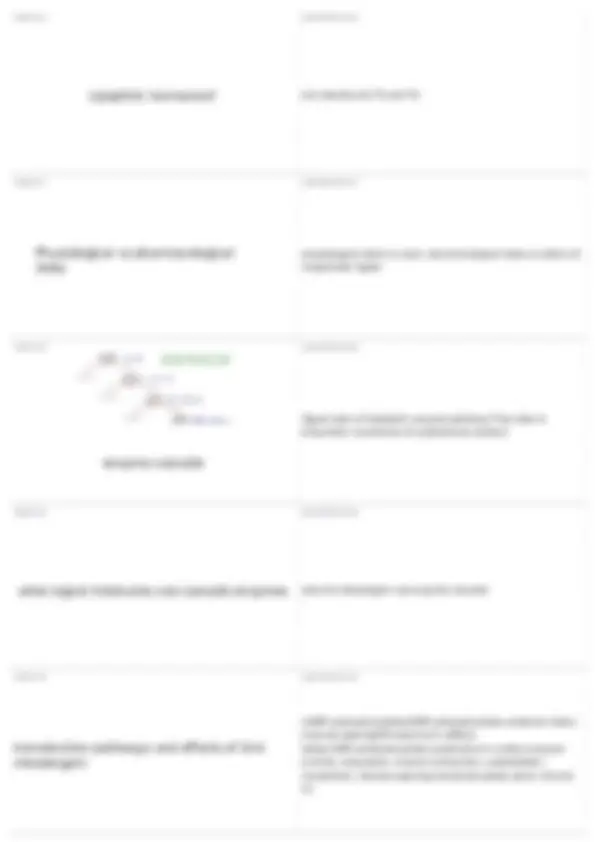












Study with the several resources on Docsity

Earn points by helping other students or get them with a premium plan


Prepare for your exams
Study with the several resources on Docsity

Earn points to download
Earn points by helping other students or get them with a premium plan
Community
Ask the community for help and clear up your study doubts
Discover the best universities in your country according to Docsity users
Free resources
Download our free guides on studying techniques, anxiety management strategies, and thesis advice from Docsity tutors
Definitions and explanations of various types of signals and hormones, including autocrine, paracrine, endocrine, and neurotransmitters. It also covers the concepts of signal transduction, receptors, and second messenger systems. Definitions of key terms such as agonists, antagonists, up-regulation, down-regulation, and neural and endocrine reflexes.
What you will learn
Typology: Quizzes
1 / 18

This page cannot be seen from the preview
Don't miss anything!











DEFINITION 2 form direct cytoplasmic connections between adjacent cells. TERM 3
DEFINITION 3 require interaction between membrane molecules on two cells. TERM 4
DEFINITION 4 act on the same cell that secreted them TERM 5
DEFINITION 5 are secreted by one cell and diffuse to adjacent cells.
The action of a hormone distant from its site of secretion. ( see also paracrine) TERM 7
DEFINITION 7 signal transduction pathways use membrane receptor proteins and intracellular second messenger molecules to translate signal information into an intracellular response TERM 8
DEFINITION 8 are secreted by endocrine glands or cells into the blood. only target cells with receptors for the hormone respond to the signal. TERM 9
DEFINITION 9 are chemicals secreted by neurons that diffuse across a small gap junction to the target cell. TERM 10
DEFINITION 10 are chemicals released by neurons into the blood for action at distant targets.
is a decrease in receptor number. the cell can physically remove receptors from the membrane through endocytosis. TERM 17
DEFINITION 17 the state or process that occurs when no more of something can be absorbed, combined with, or added. TERM 18
DEFINITION 18 sensor-special and somatic sensoryinput signal- sensory neuronintegrating center- brain and spinal cordoutput signal- efferent neuron (electrical signal and neurotransmitter)target-muscles and glands, some adipose tissueresponse-contraction and secretion primarily; may have some metabolic effects TERM 19
DEFINITION 19 sensor, input signal, integrating center and output signal same as above.-target-most cells of the body-response- change in enzymatic reactions, membrane transport, or cell proteins TERM 20
DEFINITION 20 sensor-endocrine cellinput signal-noneintegrating center- endocrine celloutput signal-hormonetargets and response same as above.
signal molecule binds to membrane receptor protein activates intracellular signal molecule alters target proteins create a response. TERM 22
DEFINITION 22 endocrine and nervous TERM 23
DEFINITION 23 -exert effects over long distance. -time period of effects is variable TERM 24
DEFINITION 24 chemical signals bind to receptors and change intracellular signal molecules that direct the response TERM 25
DEFINITION 25 lipophilic signal molecules enter the cell and combine with cytoplasmic or nuclear receptors. lipophobic signal molecules and some lipophilic molecules combine to membrane receptors.
During G-protein activation, some calcium is released that was Stored in ER. Small changes in [Ca++] are large signal to cellfor figure see page 187 TERM 32
DEFINITION 32 Actions Binds to calmodulin: alters NZ activity and/or transporter activity Binds to regulatory proteins: contraction of muscle, triggers exocytosis of secretory vesicles Binds directly to gated ion channels Initiates embryonic development TERM 33
DEFINITION 33 Hydrophilic hormones (most amino acid based peptides/proteins) are soluble in water and insoluble in lipids.Lipophilic hormones (steroids and thyroxine) are insoluble in water and soluble in lipids. TERM 34
DEFINITION 34
1. Amine ligands - derived from tyrosine or tryptophan (include norepinephrine, epinephrine, thyroxine, melatonin)2. Polypeptide/protien ligands - chains of amino acids (iinclude ADH, GH, insulin, oxytocn, glucagon, ACTH, PTH)3. Glycoproteins - protein + carbohydrate group (include LH, FSH, TSH)4. Steroids - lipids derived from cholesterol (include testosterone, estrogen, progesterone, and cortisol) TERM 35
DEFINITION 35 Hydrophilic hormones are synthesized by the rough ER and modified in the Golgi Bodies. There must be a need for synthesis, and they are similar to other proteins in the cell. They are finally stored in vesicles for exocytosis.
Lipophilic hormones typically derive from a cholesterol precursor, via enzymatic modification. Their secretion depends upon their synthesis. Only cholesterol precursor is stored. And since they're soluble (and thus permeable to the plasma membrane) they go right through into the bloodstream. TERM 37
DEFINITION 37 Hydrophilic hormones readily dissolve in the plasma. They meet their receptors on the surface of the outer membrane for their target cells. TERM 38
DEFINITION 38 Transported in blood plasma by carrier proteins.Steroid:Progesterone, Aldosterone, Testosterone, Estradiol, CortisoneNon-steroid:Thyroid hormones, Retinoic acid, Vitamin D, Thyroid hormonesAll diffuse through the PM and interact with a cytoplasmic receptor which moves them to the nucleus TERM 39
DEFINITION 39 Hydrophillic hormones receptors are one the surface of target cellLiophilic hormones can easily pass through plasma membrane TERM 40
DEFINITION 40 alter membrane ion permeability by opening and closing channcels. They also may activate a messenger system, which alters the protein activiity within the cell, to elicit a specific response.
figure 6.3 page 179 TERM 47
DEFINITION 47 T4 is reservoir of hormoneT3 is active in target cells Free T is converted to T TERM 48
DEFINITION 48 Thyroxine (T4, tetraiodothyronine) and triiodothyronine (T3) secreted from thyroid gland Ratio is 9:1 T4 over T3 Carried in blood bound to thyroxine-binding globulin (TBG)Higher affinity for T TERM 49
DEFINITION 49
DEFINITION 50 ligand binding opens or closes the channels
region of it that acts as a gate that blocks ions from flowing through protein into cell, if signal (ligand) attaches it causes gate to open, then Na and Ca and K+ can flow freely into cell. when ligand leaves gate closes TERM 52
DEFINITION 52 ligand binding to a receptor-enzyme activates an enzyme intracellularly (inside cell). GTP is transformed to cAMP. this causes downstream signaling of other secondary messengers in the cell. TERM 53
DEFINITION 53 Tryosine kinase transfers a phosphate group from ATP to a tryosine (an amino acid) or a protein. In the extracellular fluid is a signal molecule that binds to surface receptor. which activates tryosine kinase on cytoplasmic side in the cell membrane. which leads to phosphorylated protein. (ATP + protein + attaches to active binding site and makes a protein plus a P (ADP)). TERM 54
DEFINITION 54 Signal molecule binds to a G-protein coupled receptor which activates G-protein. G-protein turns on adenylyl cyclase, an amplifier enzyme. Adenyly cyclase converts ATP to cyclic AMP. cAMP activates protein kinases A. Protein kinase A phosphorylates other proteins, leading ultimately to a cellular response. TERM 55
DEFINITION 55 With phosphlipase C: Hormone binds to receptor protein. G-protein dissociates, beta gamma subunit binds to phospholipase C (amplifier enzyme). PM phospholipds are split into inositol triphosphate (IP3) and diacylglycerol (DAG); second messengers. IP3 diffuses throughthe cytoplasm to ER receptors. Binding of IP to ER receptors opens Ca++ channels. Rapid but transient rise in [Ca++] opens channels in the PM. Ca++ binds to calmodulin. activated calmodulin activates protein kinase C enzymes which phosphorylate other enzymes
cAMP=activates protein kinase, especially PKA binds to ion channels. cGMP=activates protein kinase, especially PKG and/or binds to ion channels.IP3= release of Ca2+ from intracellular storesDAG=activates protein kinase CCa2+=binds to calmodulin, binds to other proteins.see page 182 TERM 62
DEFINITION 62 one signal molecule results in multiple second messengers. i.e. amplifier enzymes activates several molecules which in turn each activates other molecules. TERM 63
DEFINITION 63 the G-protein adenyly cyclase-cAMP system is the signal transduction system for many protein hormones. In the system Adenyly cyclase is an amplifier enzyme that converts ATP to 2nd messenger cAMP. TERM 64
DEFINITION 64 Phosphlipase C is also an amplifier enzyme. it converts a membrane phosphlipid into two lipid derived second messengers. Guanylyl cylclase is an amplifier enzyme that converts GTP to cGMP TERM 65
DEFINITION 65 Guanylyl cylclase is an amplifier enzyme that converts GTP to cGMP
are steroid and T3 and T TERM 67
DEFINITION 67 physiological dose is small, pharmacological dose is orders of magnitude higher TERM 68
DEFINITION 68 Signal sets of metabolic enzyme pathway Final step is enzymatic conversion of substrate to product TERM 69
DEFINITION 69 second messengers use enzyme cascade TERM 70
DEFINITION 70 cAMP=phosphorylatescGMP=phosphorylates proteins/ alters channel openingIP3=see Ca2+ effects below.DAG=phosphorylates proteinsCa2+=alters enzyme activity. exocytosis, muscle contraction, cytoskeleton movement, channel opening.memorize power point. 50 and 51
Small amounts of a hormone increase the sensitivity of the target cells to further hormone stimulation. Subsequent release of the hormone causes a greater response Mediated through an increase in receptors TERM 77
DEFINITION 77 Prolonged exposure to high concentrations decrease the sensitivity of the target cells to further hormone stimulation Subsequent exposure to the same concentration elicits a smaller response Mediated by a decrease in receptors TERM 78
DEFINITION 78 Target organ removal Liver metabolism TERM 79
DEFINITION 79 see table 6.2 and 6.3 powerpoint slide 70 and 71 TERM 80
DEFINITION 80 always on, vary intensity, it regulates physiological parameters in an up down fashion. the signal is always present but changes in intensity
uses different signals to send a parameter in opposite directions. in this example antagonistic neurons control heart rate: some speed it up, while others slow it down. ex: stimulation by sympathetic nerves increase heart rate. stimulus by parasympathetic nerves decreased heart rate. TERM 82
DEFINITION 82 Nervous system Endocrine system Both Variations in speed, specificity, signal type, duration of action, and coding TERM 83
DEFINITION 83 eat a meal-> blood glucose falls and stretch receptors in digestive tract goes to afferent neuron, goes to CNS, goes to efferent neuron which targets pancreas creates insulin targets tissue glucose uptake increases blood glucose drops and it goes to negative feedback TERM 84
DEFINITION 84 of or related to nerves or nervous system. EX: reflex arc. TERM 85
DEFINITION 85 either a) activate protein kinaseses, which are enzymes that transfer phosphate group from ATP to a protein. phosphorylation is an important biochemical method of regulating cellular process. b) activate amplifier enzymes that create intracellular second messengers.